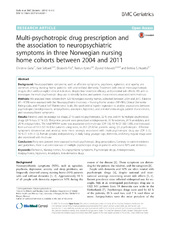| dc.description.abstract | Background Neuropsychiatric symptoms, such as affective symptoms, psychosis, agitation, and apathy are common among nursing home patients with and without dementia. Treatment with one or more psychotropic drug is often without explicit clinical indication, despite low treatment efficacy, and potential side effects. We aim to investigate the multi-psychotropic drug use to identify factors and patient characteristics associated with multi-use. Methods We analysed three cohorts from 129 Norwegian nursing homes, collected between 2004 and 2011. Patients (N = 4739) were assessed with the Neuropsychiatric Inventory – Nursing Home version (NPI-NH), Clinical Dementia Rating scale, and Physical Self Maintenance Scale. We used ordinal logistic regression to analyse associations between psychotropics (antidepressants, antipsychotics, anxiolytics, hypnotics, and anti-dementia drugs), patient characteristics, and neuropsychiatric symptoms. Results Patients used on average 6.6 drugs; 27 % used no psychotropics, 32 % one, and 41 % multiple psychotropic drugs (24 % two, 17 % ≥3). Thirty-nine percent were prescribed antidepressants, 30 % sedatives, 24 % anxiolytics, and 20 % antipsychotics. The total NPI-NH score was associated with multi-use (OR 1.02, 95 % CI 1.02–1.03), and increased from a mean of 13.5 (SD 16.3) for patients using none, to 25.5 (21.8) for patients using ≥3 psychotropics. Affective symptoms (depression and anxiety) were most strongly associated with multi-psychotropic drug use (OR 1.10, 95 % CI: 1.09–1.12). Female gender, independency in daily living, younger age, dementia, and many regular drugs were also associated with multi-use. Conclusion Forty-one percent were exposed to multi-psychotropic drug prescriptions. Contrary to current evidence and guidelines, there is an extensive use of multiple psychotropic drugs in patients with severe NPS and dementia. | en_US |

